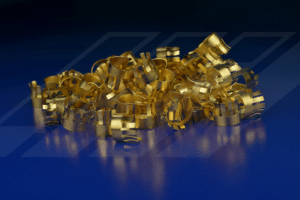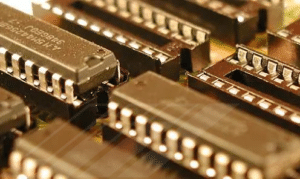Gold has and continues to be a principle finish for electrical components especially with the continuing miniaturization of electronics. One of the primary benefits of gold plating services is a finish that is both conductive and receptive to soldering. When soldering gold plated components there are a variety of important considerations when specified the surface finish. The primary considerations are thickness, purity and the proper selection of an underplate.
Plating Thickness
Gold plating thickness is a critical, and often misunderstood, tenant of gold soldering. In gold soldering the physical bond is made between the underlying nickel layer and the solder itself, with the gold layer serving as barrier to help maintain the solderability of the nickel layer. Typical gold thickness for solderability is in the range of 10uin to 30uin as it provides adequate protection against oxidation to preserve wetting while keeping the cost of the finish as competitive as possible.

Purity

Nickel purity is critical as this layer is the functional bonding layer. For nickel soldering the higher purity nickel the better the soldering. Often plating companies use an organically brightened nickel layer such as a brightened Watts or sulfate-based nickel to give a bright finish at the expense of solderability. Advanced Plating Technologies offers an engineered sulfamate nickel-plating layer recommended as an underplate for gold plating including soldering applications. This nickel system is free of codeposited organics that can outgas or volatilize during soldering thereby causing voids in the solder joint.
Another common underplate for gold plating is electroless nickel. While there are many advantages to electroless nickel plating including hold tight tolerances, large deposit range, corrosion protection, lubricity – one issue is that phosphorus is deposited in conjunction with nickel on the surface. The phosphorous acts as an impurity in soldering and can impedes soldering. When specifying electroless nickel deposits a medium phosphorous electroless nickel can give you the balance of the positives of electroless nickel while preserving solderability.
Solder Process

Conclusion
Soldering to gold plating is becoming more and more prevalent with the rise in high-end microelectronics. More than ever it is important to understand the process of soldering to gold and designing surface finishes to provide the most robust, cost effective finish. The proper gold finish must balance corrosion and wear performance with solderability to ensure the best possible design. A member of Advanced Plating Technologies technical sales staff can assist with designing a finish the meets the specific design requirements of your application.
Blog Authored by William Troske., Process & Estimating Engineer
Edited by Matt Lindstedt, P.E. , President
References:
- Ronald A. Bulwith ; Soldering to Gold – A Practical Guide








